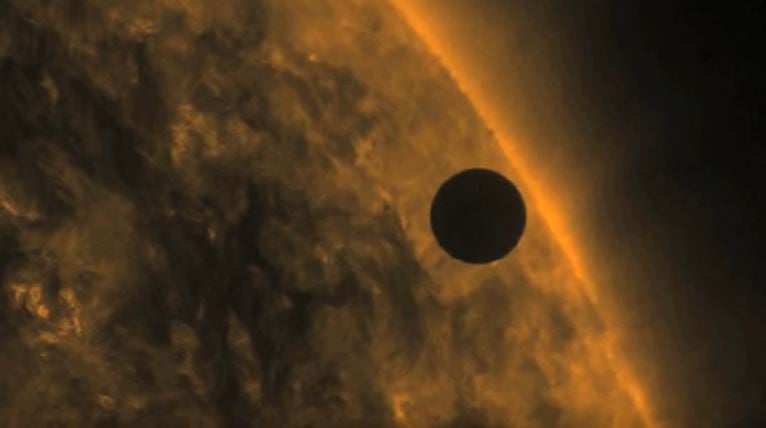Scientists have discovered the closest Earth-sized exoplanet so far – just 39 light-years from our planet, GJ 1132b is a rocky world like ours, and orbits a small star. In ‘Star Wars’ language, its deserts are probably “more inhospitable than the deserts of Tatooine”, and it would be “the polar opposite of frigid Hoth”. (An exoplanet is a planet outside our Solar System that orbits a star.)
However, rather than being in a far-away galaxy, this exoplanet, galactically speaking, is virtually next door, a team of astrophysicists from MIT and other research centers wrote in the academic journal Nature.
Zachory Berta-Thompson, a postdoc in MIT’s Kavli Institute for Astrophysics and Space Research, and colleagues from France, Portugal, Belgium and Brazil, believe the planet is too hot for human life – surface temperatures are likely to be a super-sizzling 500 °F (260 °C). GJ 1132b is likely tidally locked, i.e. it has a permanent night and day side, with the same side facing its star all the time, in the same way our Moon is locked to Earth.
 The 0.3% dimming of starlight meant that a planet was probably passing in front of one of the stars. (Image: MIT)
The 0.3% dimming of starlight meant that a planet was probably passing in front of one of the stars. (Image: MIT)
With such scorching temperatures, the planet is unlikely to retain liquid water on its surface, thus making it completely inhospitable for any kind of life as we know it. However, the authors believe it is cool enough for a substantial atmosphere.
Being relatively close to Earth means researchers should soon find out much more about its characteristics, including what its atmosphere consists off, what wind patterns there are – and even what color its sunsets are.
May have a substantial atmosphere
Dr. Berta-Thompson said:
“If we find this pretty hot planet has managed to hang onto its atmosphere over the billions of years it’s been around, that bodes well for the long-term goal of studying cooler planets that could have life.”
“We finally have a target to point our telescopes at, and [can] dig much deeper into the workings of a rocky exoplanet, and what makes it tick.”
The astrophysicists discovered the exoplanet using the MEarth-South Observatory, an array of eight 40-centimeter-wide robotic telescopes located in the Andean mountain range in Chile. The Harvard University-led array monitors M dwarfs (type of dwarf stars), which are seen all over the night sky.
Scientists say M dwarfs are frequently orbited by planets, but nobody has found an Earth-sized exoplanet that is close enough to study in depth.
Since the beginning of last year, the telescope array has been gathering data virtually every night, taking measurements of light in the sky every 25 minutes in search of the telltale star dimming that may indicate that a planet is orbiting in front of a star.
Slight dip detected in starlight intensity
On 10th May, one telescope detected a slight dip from GJ 1132 located 39 light-years (12 parsecs) from Earth.
 Zachory K. Berta-Thompson is a Torres Fellow for Exoplanetary Research, Massachusetts Institute of Technology, Kavli Institute for Astrophysics & Space Research. (Image: space.mit.edu)
Zachory K. Berta-Thompson is a Torres Fellow for Exoplanetary Research, Massachusetts Institute of Technology, Kavli Institute for Astrophysics & Space Research. (Image: space.mit.edu)
Dr. Berta-Thompson said:
“Our galaxy spans about 100,000 light-years. So this is definitely a very nearby solar neighborhood star.”
The robotic telescope immediately began observing GJ1132 every 45 seconds to confirm the measurement – a 0.3% dimming of the starlight. Later, the scientists pointed other telescopes in Chile at the star, and found that the 0.3% dimming occurs every 1.6 days – suggesting that a planet passes in front of it regularly.
Dr. Berta-Thompson said:
“We didn’t know the planet’s period from one single event, but when we phased many of them together, this signal popped out.”
Exoplanet’s size, mass, density and composition
Based on how much of the star’s light the planet blocks, the researchers estimated that planet GJ 1132b is about 1.2 times the size of our Earth. The wobble of its host star helped the team determine that its mass is about 1.6 times that of Earth.
They believe the exoplanet is rocky, like Earth. However, that is where the similarities end – its surface is super hot.
Dr. Berta-Thompson explained:
“The temperature of the planet is about as hot as your oven will go, so it’s like burnt-cookie hot. It’s too hot to be habitable – there’s no way there’s liquid water on the surface. But it is a lot cooler than the other rocky planets that we know of.”
It is still an interesting planet to study. Most other rocky worlds that have been discovered are basically fireballs, with surface temperature exceeding several thousand degrees – far too hot for any kind of atmosphere. Planet GJ 1132b, however, is cool enough to have a rich atmosphere.
Dr. Berta-Thompson said:
“This planet is cool enough that it can retain an atmosphere. So we think this planet probably still has something of a substantial atmosphere, in its current state.”
The researchers hope they will be able to use the larger successor to the Hubble Space Telescope – the James Webb Space Telescope (JWST) – which is scheduled for launching in 2018. If they do, they will be able to determine the color and chemical makeup of the planet’s atmosphere, as well as its wind patterns.
Dr. Berta-Thompson said:
“We think it’s the first opportunity we have to point our telescopes at a rocky exoplanet and get that kind of detail, to be able to measure the color of its sunset, or the speed of its winds, and really learn how rocky planets work out there in the universe. Those will be exciting observations to make.”
“Of the billions of star systems in the Milky Way galaxy, about 500 are closer than GJ1132. TESS (Transiting Exoplanet Survey Satellite) will find planets around some of these stars, and those planets will be valuable comparisons for understanding GJ1132b and rocky planets in general.”
Prof. Jonathan Fortney, who works at the University of California at Santa Cruz, also commented that planet GJ1132b may have a substantial atmosphere, given that it is much cooler than the other rocky exoplanets discovered so far.
Prof. Fortney, who was not involved in this study, said:
“What is tremendously exciting to me is that this planet could be a real ‘cousin’ of Venus and Earth. I think that this planet’s atmosphere, when we are able to try to determine what it is made of, will be an interesting data point in understanding the diversity in atmospheric composition for Earth-sized planets.”
“In our solar system, we only have two data points: Earth and Venus. Before we can understand habitability, I think we need to understand the range of atmospheres that nature makes, and why.”
This study was partly supported by the National Science Foundation, the MIT Torres Fellowship for Exoplanet Research, the David and Lucile Packard Foundation, the Harvard-Smithsonian Center for Astrophysics, and the John Templeton Foundation.
Citation: “A rocky planet transiting a nearby low-mass star,” Zachory K. Berta-Thompson, Jason A. Dittmann, Jonathan Irwin, David Charbonneau, Elisabeth R. Newton, Thierry Forveille, Nicola Astudillo-Defru, Xavier Bonfils, Michaël Gillon, Vasco Neves, Emmanuël Jehin, Antony A. Stark, Brian Stalder, Francois Bouchy, Xavier Delfosse, Christophe Lovis, Michel Mayor, Stéphane Udry, Francesco Pepe, Nuno C. Santos & Anaël Wünsche. Nature. 12 November, 2015. DOI: 10.1038/nature15762.
Video – New Earth-like exoplanet discovered

